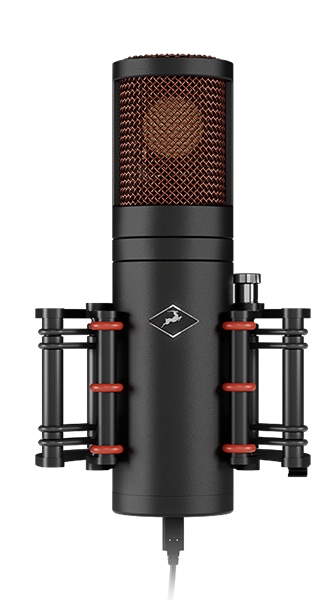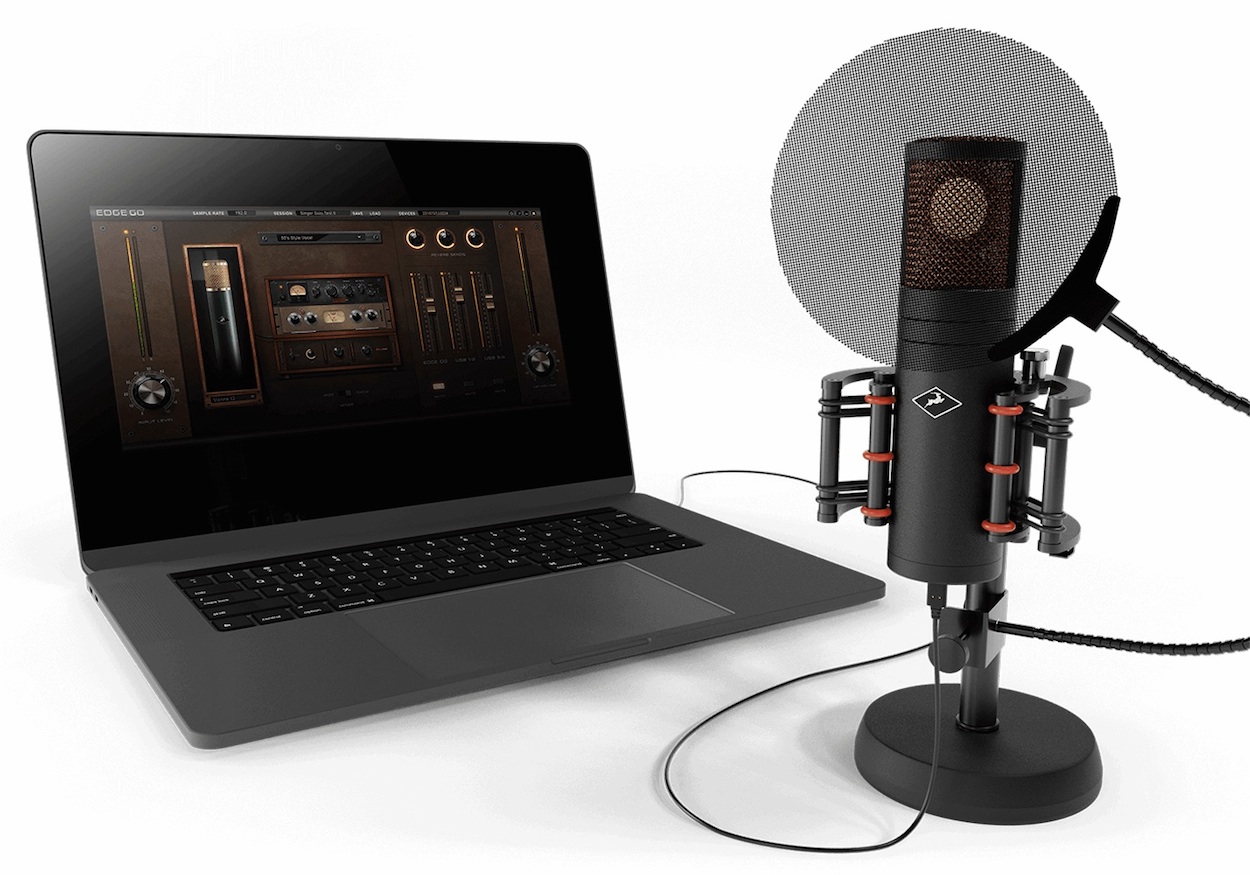New Gear Review: Edge Go Modeling Mic by Antelope Audio
Modeling mics are no longer in their infancy—let’s call it toddlerhood. The tech is young, and the promise is great. Slate first broke open this market with their now-famous mic modeling packages, and Antelope stepped into the ring soon after with their own ecosystem of modeled mics, pres, comps, and EQs.
Now we see a further evolution from Antelope with the Edge Go, a mic that harnesses their modeling prowess and stuffs it all into a USB-C package that frees you from needing specialized external hardware. The capsule, the processing, the monitoring output—it’s all found on the mic. Depending on your use-case, this product aims to be the most portable studio mic locker ever devised, or the most souped-up podcasting package available yet.
I raised my hands immediately when the chance came to review it—who wouldn’t?
Features
If the solidity of things impresses you, you’ll be won over by the Edge Go, as it feels reassuringly durable in your hand. Its travel case includes a basket, mic thread adapter, desktop stand, pop filter, USB cable, and padded stowaway room for each item.
Once hooked up, provided that process goes smoothly on your system (more on that later), you’ll have access to a wide array of mic emulations, including a 67, 87, 47 FET, C800G, 121 ribbon, and much, much more. The mic itself hosts two capsules that give you the ability to achieve cardioid, omnidirectional, and figure-8 polar patterns. Microphones that traditionally sport continuously-variable polar patterns continue to offer their customary fluidity.
Pres, compressors, EQs, gates, and more are made possible through Antelope’s FGPA processing. Want your Neve sound? Check out the BAE preamp offered. Need something cleaner? A Gyraf preamp is supplied. Want an 1176- or Altec-style comp? You got it.
Open the mixer window and you’ll notice three faders: your incoming signal, everything you assign to outputs 1 & 2, and everything you assign to outputs 3 & 4. In my DAW, I had to assign all outputs I wanted to monitor to 3 & 4, less I hear my voice doubled through the processing.
Record through channels 1 & 2 to commit the sound of your emulated chain to tape—mic model, preamp, compressor, and all. If you want dry audio to process later, record through 3 & 4. You can run both at the same time.
Antelope’s native emulations will only give you the ability to process the mic model in post (i.e., after recording). If you don’t record through their pres, EQs, or compressors, you’ll have to use other software in the mix stage, or run the signal back through the Edge Go in real time.
In Use
I used the mic on sung vocals, spoken vocals, and electric guitar.
Here’s a snippet of acoustic guitars through a 414 mic, a C12, and a ribbon based on the Coles 4038:
Electric guitars through the Royer emulation sound pretty rad, I have to say:
But for a different timbre, I could try the 67 in omni and achieve something satisfying:
As for sung vocals, let’s show you the 67, the 87, the Tokyo 800, and the Edge Go—no sleeper in and of itself.
Antelope graciously gave me a while to explore the microphone, which was to my benefit: the more I used it, the better I liked it—and the quality of the resulting recordings was surely worth it. Having the ability to switch microphones for every background vocal added a lushness to stacked background parts I couldn’t have possibly achieved using the same mic model on every take.
However, there are some areas in which, if pressed, I would have to be critical.
To Be Critical
A USB cable—my journey began there.
I downloaded the drivers, plugged in the mic via USB, launched the control panel, and…nothing worked.
I RTFM (look it up), but nothing worked.
I emailed a lovely and helpful rep, got an updated driver, but nothing worked.
He passed me on to a tech specialist, who told me the issue was endemic to the version of the Edge Go they gave me: I would either need to rotate the USB-C cable in the mic itself (that didn’t work) or buy a new USB-A to USB-C cable, under 2 meters long.
Then subsequently, Antelope told me that the 4-meter cable they initially provided was found insufficient; it could not power computer systems. I was then finally assured that Antelope now supplies a 2-meter cable with all orders of the Edge Go.
Once I got the mic powered up I was able to set about putting it to use, but off the bat I noticed some strange things:
I found significant handling noise coming through the USB cable. Tap upon it, and you’d hear what sounded like taps on a capsule. I can’t say if this was the mic’s fault or the cables fault, though this seemed to be the case with all the cables I tried. Not necessarily a drawback, but very weird to behold.
Antelope told me the cables they provide are shielded—that they do not exhibit handling noise when you tap on them. This could very well be true; I was told to supply my own cables for the test, after all. I will say, however, that with other USB mics I’ve used, I’ve always heard the same weird handling noise.
In my room, on my setup, a figure-8 polar pattern always contributed a weird, static hiss. I checked with the rep—apparently this was a known issue with the prototype they gave me: one capsule’s noise floor was lower than the other.
I bring up this story to illustrate two things: that the mic exhibited issues upon setup, and that Antelope was very quick to make sure these issues were ameliorated. Both of these facts say a great deal, and should influence your decision as to whether to purchase the product.
Moving on: I found the tone of these emulations, and their receptivity to processing, quite lovely indeed. They served me well in several professional circumstances. But I found the feel of them to be, well, somewhat weird. I can’t quantify the phenomenon in objective terms, so you’ll have to make due with my subjective experience:
When you test out your voice on a great, analog mic chain, you hear your voice come alive in this amazing, reactive way, as though it couldn’t possibly be you making those sounds. I’m sure anyone who’s been on the performer’s side of the glass knows what I mean: the mic interplays with your voice; you hear aspects of your voice you’ve never noticed before. The performance changes as a result—you begin to notice that if you tilt your head one way, or elongate your throat differently, you get a different resonance out of your voice. It’s a playful part of the process that helps you in the studio.
The Edge Go doesn’t provide this experience immediately, at least not in my case. What I felt while using the mic was a sort of filtering effect—the emulation of gear rather than the aliveness of it. Indeed, if you take any of the provided A/B samples and attempt a null test, you’ll hear what appears to be a difference in filtering. You won’t hear a push in dynamics; just a static, filtered difference. This suggests the emulations lay primarily in the EQ side of things, rather than any harmonic or dynamic modeling.
The experience is somewhat akin to putting the best room-correction software on your monitors. At least at first, yes, you notice the change it makes in revealing certain aspects of the sound, but you may also feel a palpable distance, an intermediary step between speakers and ears to which it takes a moment to adjust.
Still, as I worked with the mic over several months, this aliveness grew—my perspective to it changed, and I began to elicit that responsive, reactive feeling one gets from top-notch gear. For me, however, it was not an immediate light-switch moment. It was a subtler experience, one of drawing out the mic over time to really understand it.
By the end of the process I did not want to give it back—so that should tell you something. Take this critical piece as just one person’s perspective: if you don’t like how it feels right off the bat, give it some time, give it some practice, and always listen to the results—if they smoke your current mic setup, you can’t beat it, not for its portability and functionality.
Summing it Up
If I weren’t reviewing the Edge Go, would I buy it? Probably not, but only because it doesn’t suit my needs. Aggregating the USB interface to my Lynx card is a real pain in the neck. If I were on a mission to get mission-critical vocals on the go—if I were a traveling producer or a podcaster interested in acquiring sounds a cut-above—the answer might be different.
But passing up on the Edge Go doesn’t mean I’d pass up on Antelope as a platform. After hearing this mic in action over the long haul, I’m excited to pick up something that integrates Antelope’s technology with my particular system. I’m hoping I won’t have to wait very long.
To download the full resolution audio files from this review, click here for Part 1; click here for Part 2.
– As a composer of musicals, Nick Messitte has seen his work enjoy the stages of Edinburgh’s Fringe Festival and New York’s Musical Theater Festival to critical acclaim; as a guitarist, he’s played with internationally renowned musicians, including Sam Rivers, Hawksley Workman, Gary Thomas, Devin Grey and Daniel Levine. Nick is also a sound designer of theater and film (with credits such as the award winning I Hate Myself and Sumi) and a producer/engineer of records (credits include Bullet Proof Stocking’s critically acclaimed EP Down To The Top, which Nick mixed, mastered, and supplied with additional instrumentation). Lastly, he is a writer/cultural critic, whose musings can be seen regularly at Forbes.com.
Please note: When you buy products through links on this page, we may earn an affiliate commission.








